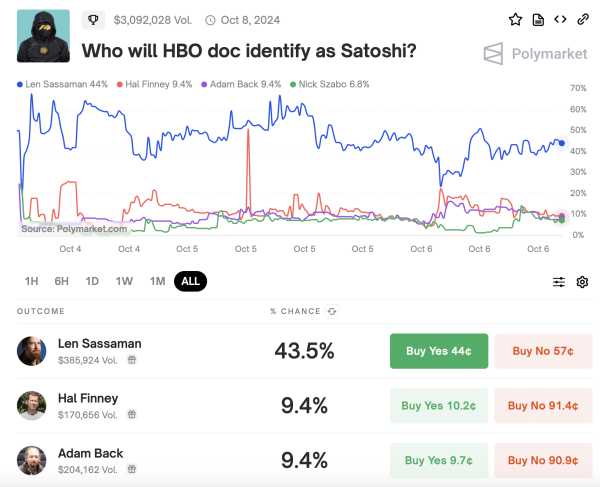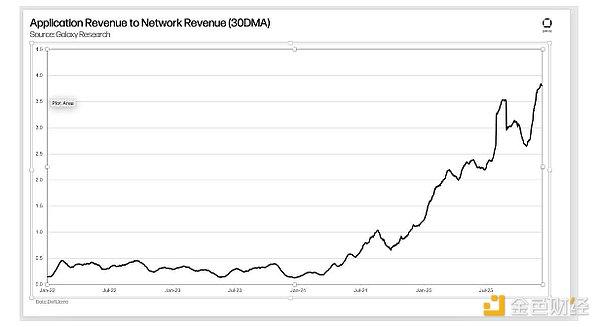The American television company HBO will officially broadcast the Bitcoin documentary "Money Electric: The Bitcoin Mystery" on October 8. It is said that in this film, the true identity of Satoshi Nakamoto, the creator of Bitcoin, will be revealed. identity. This film has also caused betting on the prediction market Polymarket. The most popular candidate is the cryptographer Len Sassaman who committed suicide in July 2011. Who is he? In 2021, some people actually discussed this conjecture in depth .

Table of Contents
ToggleLen Sassaman and Satoshi Nakamoto: Unraveling the Cryptopunk Saga
The article stated that there is a sentimental tribute in the Bitcoin network: an obituary encoded in the blockchain is a silent tribute to Len Sassaman, an outstanding cypherpunk. His legend is closely tied to the story of Satoshi Nakamoto, the anonymous founder of Bitcoin. However, what if Satoshi Nakamoto was more than just an unknown genius? What if Len Sassaman himself had played a key role in the creation of Bitcoin and contributed to it before his untimely death?

Died young, a Bitcoin-style tribute
On July 3, 2011, Len Sassaman unfortunately committed suicide at the age of 31, leaving a huge void in the hacker and cryptography communities. A highly regarded cypherpunk, Sassaman's contributions to cryptography, privacy technology, and peer-to-peer (P2P) networking have made him a key figure in the development of digital privacy.
Block 138,725 of the Bitcoin blockchain contains a tribute to Sassaman, essentially immortalizing the architecture he may have influenced. While Sassaman's connection to Bitcoin is speculative, there is a disturbing coincidence between his death and Satoshi Nakamoto's sudden disappearance two months ago.
Satoshi Nakamoto disappeared in the same year as Sassaman hanged himself.
Bitcoin's mysterious inventor Satoshi Nakamoto seemed to "disappear" from the digital world in 2011, leaving behind a vague message: "I have moved on to other matters and may not appear again in the future." This message was released Two months before Sassaman's death. Satoshi Nakamoto made a total of 169 code commits and published 539 articles since Bitcoin was launched, but suddenly, before completing his work or unlocking his massive Bitcoin fortune worth $64 billion, he Then disappeared.
The connection between Satoshi Nakamoto and Sassaman’s death raises many questions. While many have speculated on the identity of Satoshi Nakamoto, some believe it is time to revisit the cryptopunk movement.
Len Sassaman: Self-taught cryptography wizard
Len Sassaman is a self-taught technologist with a deep interest in cryptography and P2P protocols. As a teenager in Pennsylvania, USA, he had already contributed to the Internet Engineering Task Force (IETF) and was committed to the development of protocols such as TCP/IP. Diagnosed with depression at a young age, he encountered challenges in receiving psychiatric treatment that left him distrustful of authority.

At the age of 18, Sassaman moved to the San Francisco Bay Area and became an active member of the cryptopunk community, living and collaborating with BitTorrent creator Bram Cohen. He was widely known for his intelligence, passion for privacy, and his fearless sense of humor.
Contributed to PGP and cryptography, worked with Hal Finney
Sassaman quickly rose to prominence in the field of cryptography. By the age of 22, he was speaking at conferences and co-founding a startup focused on public-key cryptography with open-source software advocate Bruce Perens. Afterwards, he joined Network Associates and participated in the development of PGP (Pretty Good Privacy), the core encryption technology related to Bitcoin's security infrastructure.
It is worth noting that Hal Finney, another key figure in the cryptopunk movement, also participated in the development of PGP and was deeply involved in the early development of Bitcoin. As the first person to receive a Bitcoin transaction directly from Satoshi Nakamoto, Finney's connections to Bitcoin are widely known and he is one of the most credible candidates to be suspected of being Satoshi Nakamoto. He works closely with Sassaman at Network Associates.
Remailer: The predecessor of Bitcoin
Both Sassaman and Finney were deeply involved in the development of remailer technology, which can be said to be the predecessor of Bitcoin's P2P structure. Remailer is a server designed to send messages anonymously based on a concept proposed by cryptographer David Chaum. The most popular remailer program, Mixmaster, relies on decentralized nodes and encrypted data blocks, a design that foreshadows the architecture of Bitcoin.
As the developer, node operator and main maintainer of Mixmaster, Sassaman is an expert in remailer systems. As remailers were plagued by abuse and spam issues, the cypherpunk community began to discuss digital currencies for commercialization and expansion. Many core concepts of cryptocurrency, such as anonymous payments and smart contracts, originated from the remailer community.
What do Len Sassaman and Satoshi Nakamoto have in common?
Sassaman’s resume is strikingly similar to the skills needed to develop Bitcoin. Developing such a groundbreaking protocol required extensive expertise in cryptography, P2P networks, security architecture, and a deep understanding of the ideals of the cryptopunk movement. Sassaman's work in remailers, privacy technologies, and academic cryptography research aligns closely with these necessary skills.
In addition, Sassaman's mentor is David Chaum, known as the "Father of Digital Currency." Although Chaum's Digicash project failed, its core concepts of anonymity and untraceable payments have been continued in Bitcoin.
Another clue: Satoshi Nakamoto’s connection to academia
Sassaman's academic work as a researcher and PhD candidate at COSIC Belgium allows him to continue developing privacy-enhancing protocols. His research is dedicated to finding practical applications for cryptography, combining theory with real-world applications. Notably, Sassaman’s focus on solving Byzantine fault tolerance is the final piece of the puzzle in developing a secure, decentralized cryptocurrency like Bitcoin.
Clues about Satoshi Nakamoto’s identity also hint at his academic background. The Bitcoin white paper is typeset in LaTeX, a style common in academic circles but quite rare on cryptopunk mailing lists. In addition, the time when Satoshi Nakamoto's articles and code were submitted coincided with academic breaks, which hints at an academic lifestyle.
Geographic Evidence: Europe and the Bitcoin Mystery
Sassaman's time in Belgium fits with other clues suggesting Satoshi lived in Europe. Satoshi’s use of British English, references to the euro, and a front-page headline from The Times (the UK print edition) embedded in the Bitcoin Genesis Block all hint at European connections. These clues present a paradox: Satoshi Nakamoto appears to be European, but requires sufficient knowledge of the American cryptopunk community, which is mainly concentrated in San Francisco.
Sassaman, an American who had close ties with Europe during the development of Bitcoin, fits this unique cross-regional characteristic.
Early foundation of P2P network, high probability of deriving Bitcoin
Bitcoin's architecture is deeply embedded in P2P networks. Sassaman's close relationship with BitTorrent inventor Bram Cohen and his work on MojoNation, a P2P network with its own digital currency, provided the early foundation for a decentralized economic system. Sassaman and Cohen co-founded CodeCon, a conference focused on practical programming applications, where Hal Finney presented one of the earliest P2P digital currency demonstrations.
These works, coupled with Cohen's innovations in P2P protocols and token economics, laid an important knowledge foundation for the development of Bitcoin.
The cryptopunk spirit of protecting privacy and freedom deeply influenced Sassaman and Satoshi Nakamoto. Unlike other digital currency projects that seek patents and corporate partnerships, Bitcoin is distributed as a free, open-source protocol designed to create a decentralized and anonymous financial system.
Tragic Ending: The End of the Sassaman Story
Sassaman's functional neurological disorder and depression worsened in his final years, leaving him feeling isolated and forced to maintain a false sense of self-competence. Despite deteriorating health, he continued to contribute to the cryptography community until a few months before his death.
Len Sassaman’s legacy lives on not only in the Bitcoin blockchain, but also in the ideals and development of the cryptopunk movement. While the question of Satoshi Nakamoto’s identity remains unresolved, the overlap in Sassaman’s and Satoshi’s lives provides an ongoing mystery that fascinates those curious about the origins of Bitcoin and the man behind it.







